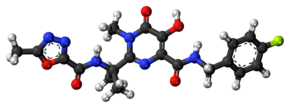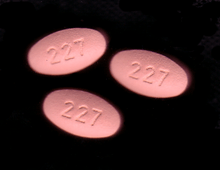Raltegravir
Raltegravir (RAL), sold under the brand name Isentress, is an antiretroviral medication used, together with other medication, to treat HIV/AIDS.[1] It may also be used, as part of post exposure prophylaxis, to prevent HIV infection following potential exposure.[2] It is taken by mouth.[1]
 | |
 | |
| Clinical data | |
|---|---|
| Trade names | Isentress |
| AHFS/Drugs.com | Monograph |
| MedlinePlus | a608004 |
| License data |
|
| Pregnancy category |
|
| Routes of administration | oral |
| ATC code | |
| Legal status | |
| Legal status | |
| Pharmacokinetic data | |
| Bioavailability | 60%(FDA) |
| Protein binding | 83% |
| Metabolism | Hepatic (UGT1A1) |
| Elimination half-life | 9 hours |
| Excretion | feces and urine |
| Identifiers | |
IUPAC name
| |
| CAS Number | |
| PubChem CID | |
| ChemSpider | |
| UNII | |
| ChEMBL | |
| NIAID ChemDB | |
| CompTox Dashboard (EPA) | |
| ECHA InfoCard | 100.124.631 |
| Chemical and physical data | |
| Formula | C20H21FN6O5 |
| Molar mass | 444.42 g/mol g·mol−1 |
| 3D model (JSmol) | |
SMILES
| |
InChI
| |
| | |
Common side effects include trouble sleeping, feeling tired, nausea, high blood sugar, and headaches.[2] Severe side effects may include allergic reactions including Stevens-Johnson syndrome, muscle breakdown, and liver problems.[2] It is unclear if use during pregnancy or breastfeeding is safe.[2] Raltegravir is an HIV integrase strand transfer inhibitor which blocks the functioning of HIV integrase which is needed for viral replication.[2]
Raltegravir was approved for medical use in the United States in 2007.[2] It is on the World Health Organization's List of Essential Medicines, the most effective and safe medicines needed in a health system.[3] The wholesale cost in the developing world is about 50 USD per month.[4] In the United Kingdom it costs the NHS about 472.00 pounds per month.[1] Lamivudine/raltegravir, a combination with lamivudine, is also available.[2]
Medical uses

Raltegravir was initially approved only for use in individuals whose infection has proven resistant to other HAART drugs.[5] However, in July 2009, the FDA granted expanded approval for raltegravir for use in all patients.[6] As with any HAART medication, raltegravir is unlikely to show durability if used as monotherapy, due to the highly mutagenic nature of HIV. Raltegravir is taken orally twice daily.[5]
In December 2011, it approval for use in children over the age of two, taken in pill form orally twice a day by prescription with two other antiretroviral medications to form the cocktail (most anti-HIV drugs regimens for adults and children use these cocktails). Raltegravir is available in chewable form, but because the two tablet formulations are not interchangeable, the chewable pills are only approved for use in children two to 11. Older adolescents will use the adult formulation.[7]
Efficacy
In a study of the drug as part of combination therapy, raltegravir exhibited potent and durable antiretroviral activity similar to that of efavirenz at 24 and 48 weeks but achieved HIV-1 RNA levels below detection at a more rapid rate. After 24 and 48 weeks of treatment, raltegravir did not result in increased serum levels of total cholesterol, low-density lipoprotein cholesterol, or triglycerides.[8][9]
Side effects
Raltegravir was generally well tolerated when used in combination with optimized background therapy regimens in treatment-experienced patients with HIV-1 infection in trials of up to 48 weeks' duration.[10]
Mechanism of action
As an integrase inhibitor, raltegravir targets integrase, an HIV enzyme that integrates the viral genetic material into human chromosomes, a critical step in the pathogenesis of HIV. The drug is metabolized away via glucuronidation.[11]
History
Raltegravir was the first integrase inhibitor to receive approval in the United States.[12][5]
Research
Raltegravir significantly alters HIV viral dynamics and decay and further research in this area is ongoing. In clinical trials patients taking raltegravir achieved viral loads less than 50 copies per millitre sooner than those taking similarly potent non-nucleoside reverse transcriptase inhibitors or protease inhibitors. This statistically significant difference in viral load reduction has caused some HIV researchers to begin questioning long held paradigms about HIV viral dynamics and decay.[13] Research into raltegravir's ability to affect latent viral reservoirs and possibly aid in the eradication of HIV is currently ongoing.[14]
Research results were published in the New England Journal of Medicine on July 24, 2008. The authors concluded that "raltegravir plus optimized background therapy provided better viral suppression than optimized background therapy alone for at least 48 weeks." [15]
Research on human cytomegalovirus (HCMV) terminase proteins demonstrated that raltegravir may block viral replication of the herpesviruses.[16]
In January 2013, a Phase II trial was initiated to evaluate the therapeutic benefit of raltegravir in treating multiple sclerosis (MS).[17] The drug is active against Human Endogenous Retroviruses (HERVs) and possibly Epstein-Barr Virus, which have been suggested in the pathogenesis of relapsing-remitting MS.
References
- British national formulary : BNF 69 (69 ed.). British Medical Association. 2015. p. 429. ISBN 9780857111562.
- "Raltegravir Potassium". The American Society of Health-System Pharmacists. Retrieved 8 December 2017.
- "WHO Model List of Essential Medicines (20th List)" (PDF). World Health Organization. March 2017. Retrieved 29 June 2017.
- "Single Drug Information". International Medical Products Price Guide. Retrieved 9 December 2017.
- "Isentress Drug Approval Package". U.S. Food and Drug Administration (FDA). February 22, 2008. Retrieved 2009-11-15.
- "UPDATE 2-FDA OKs widened use of Merck's Isentress HIV drug". Reuters. 2009-07-10.
- "FDA Okays Raltegravir for Kids, Teens with HIV".
- Markowitz M, Nguyen BY, Gotuzzo E, et al. (2007). "Rapid and durable antiretroviral effect of the HIV-1 Integrase inhibitor raltegravir as part of combination therapy in treatment-naive patients with HIV-1 infection: results of a 48-week controlled study". J. Acquir. Immune Defic. Syndr. 46 (2): 125–33. doi:10.1097/QAI.0b013e318157131c. PMID 17721395.
- Stephenson J (2007). "Researchers buoyed by novel HIV drugs: will expand drug arsenal against resistant virus". JAMA. 297 (14): 1535–6. doi:10.1001/jama.297.14.1535. PMID 17426263.
- Croxtall JD, Keam SJ (2009). "Raltegravir". Drugs. 69 (8): 1059–75. doi:10.2165/00003495-200969080-00007. PMID 19496631.
- HIV Antiretroviral Agents in Development
- "FDA approval of Isentress (raltegravir)". U.S. Food and Drug Administration (FDA). June 25, 2009. Retrieved 2009-11-15.
- Faster Viral Decay With Raltegravir
- Clinical trial number NCT00554398 for "Impact of MK-0518 (Raltegravir) Intensification on HIV-1 Viral Latency in Patients With Previous Complete Viral Suppression" at ClinicalTrials.gov
- Steigbigel RT, Cooper DA, Kumar PN, et al. (July 2008). "Raltegravir with optimized background therapy for resistant HIV-1 infection". N. Engl. J. Med. 359 (4): 339–54. doi:10.1056/NEJMoa0708975. PMID 18650512.
- Drug against AIDS could be effective against herpesvirus
- Raltegravir (Isentress) Pilot Study in Relapsing Multiple Sclerosis (INSPIRE)
External links
- Manufacturer's website
- MK-0518 at Aidsmedscom
- Integrase Inhibitor Raltegravir (MK-0518) Doubles HIV Suppression in Treatment-Experienced Patients (aidsmap 28 February 2007)
- RMK-0518 Abstract from CROI 2007
- Interim Results From Phase II Study Of MK-0518
- World patent covering the potassium salt
- Raltegravir Pharmacokinetics